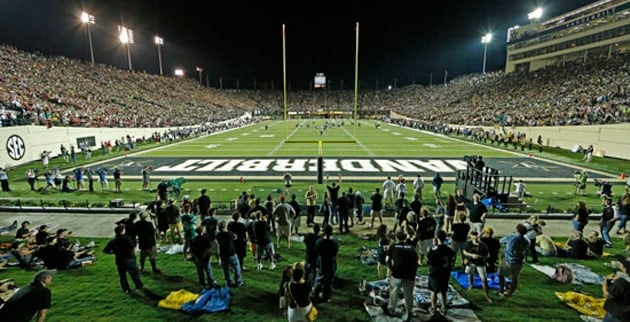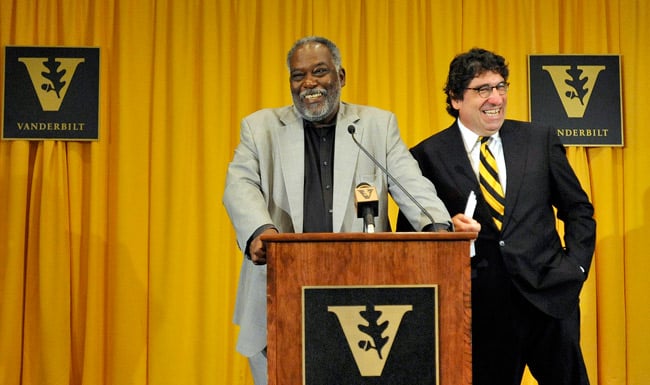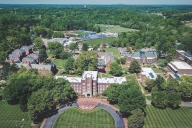You have /5 articles left.
Sign up for a free account or log in.

Vanderbilt University
Long-running tensions between athletics and academics are on display once again at Vanderbilt University, with charges surfacing that the athletics side is being prevented from raising money from some donors courted by university fund-raisers.
Blocking certain donors is undercutting efforts to raise funds for a new football stadium project, The Tennessean reported last week. Citing multiple sources, the newspaper wrote that a lack of progress toward a new or renovated stadium “may be self-inflicted.”
In an accompanying piece, columnist Joe Rexrode recounted being told two years ago by a source that athletics fund-raisers have been “scolded away from top donors” and that coaches have been frustrated because they are unable to get money for “small things that would be considered essential” at other universities.
“In this case, it’s a group of people getting together to complain because they see it as their only way to get something done,” Rexrode wrote. “And years of sitting around -- some would say negligence -- is dooming Vandy football to more losing. Losing games, losing seasons, losing fans, losing opportunities to earn new fans that should be capitalized on with vigor in this booming city.”
The situation resonates at Vanderbilt, a prestigious institution in Nashville, Tenn., where the relationship between athletics and academics has frequently been in flux over the last 15 years. The university is academically prestigious but arguably disadvantaged athletically as the only private institution competing in the keeping-up-with-the-Joneses climate of Southeastern Conference football. It is also pumping hundreds of millions of dollars into creating a "living-learning environment" elsewhere on campus, in line with the university's residential-colleges concept combining residential, classroom and student center space -- even as boosters argue its football stadium has not been significantly renovated since 1981.
For all that makes Vanderbilt unique, the tensions on display provide a glimpse into issues simmering beneath the surface at many colleges and universities. The new federal tax law just did away with the ability for donors to take a charitable deduction on a large chunk of the money they paid for athletic event seating rights, potentially making it harder to raise money for athletics. But corporate sponsorships have continued to grow in importance, slathering money on successful programs.
At the same time, there are faculty members across the country who would like to see less money flow to athletics and want more emphasis placed on what they see as the often-overlooked core of the university mission -- research and academics. Yet donors want to give for their own priorities, while sports enthusiasts and fund-raisers say giving for athletics and academics doesn’t have to be mutually exclusive.
“I think most people would say it’s not unusual to have some competition between athletics and academics, or even within academic units,” said David Bass, a senior director of research at the Council for Advancement and Support of Education.
Colleges and universities are starting to integrate and align advancement functions more and more, said Bass, who spoke about higher education philanthropy generally but not Vanderbilt specifically. Integration means making communications, alumni relations, marketing and fund-raising part of a continuum engaging people from the time they consider enrolling as students through the time they graduate and advance in age as alumni.
“Managing prospects becomes more challenging,” Bass said. “You don’t want the dean of the college of business going out and asking for a $5 million gift or a $50,000 gift three days after the president has talked with them about a $50 million gift.”
What’s in an Address?
Vanderbilt officials showed little interest in discussing The Tennessean’s report. They did confirm one detail, however: the main fund-raising group for Vanderbilt athletics, the National Commodore Club, is relocating.
The National Commodore Club is moving from McGugin Center, which houses Vanderbilt athletics, to the development and alumni relations office in the Loews Vanderbilt Plaza. The Tennessean noted Loews Vanderbilt Plaza houses the headquarters for fund-raising for non-athletics-related campus projects and cited sources who said the move “illustrates Vanderbilt’s institutional de-emphasis of athletics.”
But the National Commodore Club was always part of the university’s development and alumni relations office, according to a university spokesperson, Princine Lewis. The National Commodore Club is merely moving physical locations, and the relocation does not represent a change in structure or approach to fund-raising, Lewis said.
“Any suggestion to the contrary is false,” Lewis said in an email. “Vanderbilt remains committed to the success of its athletics program and its student athletes. The university is focused on providing student athletes with an elite education, the opportunity to participate in a top-notch conference, and the mentoring and support for success on and off the field. That is the university’s top priority in line with its academic and research mission.”
Asked for an interview with an official who could discuss fund-raising priorities, Lewis reiterated that the university’s fund-raising efforts have not changed.
“This is all we are going to have,” Lewis said in an email. “Hope this helps.”
An athletics department spokesman referred a request for comment back to Lewis.
Still, physical relocations can be worth watching, according to outside observers. They can be much more than symbolic, said Charles Clotfelter, a professor of public policy studies at Duke University who has written about big-time athletics in higher education and inequality between different colleges and universities.
“They’re doing something different,” Clotfelter said. “I’d sit up and pay attention, because this really and truly looks like something about a university’s priorities.”
Vanderbilt has long provided a unique window into the often uneasy relationship between big-time athletics and universities at large. In 2003, then chancellor E. Gordon Gee announced Vanderbilt was disbanding its athletics department and moving it into the division of student life. The decision came against a backdrop that might sound familiar today: widespread concerns about athletics scandals across the country and worries that athletic departments were becoming their own fiefdoms.
The university’s athletics director at the time soon departed. Athletics moved underneath the authority of David Williams, who was secretary of Vanderbilt’s Board of Trust, vice chancellor for student affairs and general counsel. Williams has recalled the stunned reaction to the changes from both the media and Vanderbilt’s board, telling The New York Times that Gee and Vanderbilt’s provost “found something else to do” and he spent a whole day “with the board screaming at me.”
 But in 2012, Williams received a new title under Chancellor Nicholas S. Zeppos: vice chancellor for athletics and university affairs and athletics director. Zeppos said Williams was playing an increasing role in college athletics. A university news release quoted the new athletic director as saying he would be able to spend more one-on-one time with student athletes.
But in 2012, Williams received a new title under Chancellor Nicholas S. Zeppos: vice chancellor for athletics and university affairs and athletics director. Zeppos said Williams was playing an increasing role in college athletics. A university news release quoted the new athletic director as saying he would be able to spend more one-on-one time with student athletes.
“I have heard the comments that Vanderbilt needs a full-time leader in athletics,” Williams said. “I’ve taken that to heart.”
Williams did not return an emailed request for comment for this story. He has previously estimated that a new stadium could cost more than $60 million to $90 million. The Tennessean quoted him as saying stadium upgrades are a priority within Vanderbilt’s framework.
“Oh, the desire is very much there,” Williams said. “People say that we are not interested in [a stadium project]. Trust me, there is no AD in this conference that wants to do things to win a championship more than I do.”
Several signs point to Vanderbilt’s framework emphasizing parts of the university beyond the bowl of the football stadium. The university is in the midst of a new $600 million renovation and building project on campus that doesn’t include athletics facilities.
It has emphasized construction of residential colleges in recent years, according to financial statements. In 2017, the university spent $159 million on capital projects, with more than $35 million going to academic projects and $34 million for housing projects. Just $9 million was for athletics projects. In 2016, only $6 million of $149 million in capital spending went to athletics projects.
At the same time, Vanderbilt doesn’t operate in a world of unlimited resources. Yes, it is among an elite group of wealthy institutions, with a $4.1 billion endowment, large enough to be the 24th-largest endowment in the United States and Canada. The 12,600-student university collects about $1.3 billion in revenue annually, much of it from grants, contracts and endowment earnings. But it competes against some even greater powerhouses.
Gift revenue totaled $92 million in Vanderbilt’s 2017 fiscal year, Moody’s Investors Service noted in a recent report. The ratings agency called gift revenue strong, “but below some of the university’s competitive peers.”
Donor Priorities and the Crowding-Out Effect
Fund-raising for any college or university is a mix of priorities -- both donors' and those for which the institution would like to raise money. But universities, including academically strong universities, sometimes take criticism for pumping money into athletics facilities. For example, critics recently targeted Northwestern University for opening a $270 million football practice and athletics facility on the shores of Lake Michigan.
Anecdotal evidence shows the divide between athletic and academic priorities surfaces frequently. Elizabeth King is the president and CEO of the Wichita State University Foundation. She isn’t familiar with the situation at Vanderbilt, but she recalled conversations she’s seen between fund-raising professionals on email distribution lists.
“This does seem to be problematic at a number of institutions,” she said. “It’s just the whole collaboration. Athletics has perks, many times, that the academic side can’t begin to provide.”
It takes work on all sides to keep good levels of communication flowing between different parties in fund-raising, athletics and other parts of a university, King said. The sides can work together effectively, though.
Nonetheless, a perception sometimes persists that money raised for athletics could be redirected toward academics. King remembers a faculty member asking about a major gift to Wichita State athletics. Could fund-raisers have asked for a chair in anthropology instead?
“I said, ‘What would give you any idea that that’s what he wants to do?’” King said. “The No. 1 litmus test is, ‘What is the donor passionate about, or what can you do to create a level of passion within that donor?’”
The second question seems to be a vexing one. Worries have long persisted about athletics creating a crowding-out effect, siphoning money from other institutional fund-raising.
A 2010 analysis by professors at Troy, Central Washington and Middle Tennessee State Universities looked at previous research and concluded that the performance of intercollegiate athletics is a significant influence on institutional fund-raising. Athletic success has a significant influence on all types of institutional fund-raising, although effect sizes were small. At institutions where football was played, it was the primary influence on giving.
A main takeaway of the 2010 analysis was that the relationship between athletics and overall fund-raising is complex. Authors wrote that “the strength of that relationship is moderated by four important variables: the target of the giving, the alumni status of the donor, the institution's level of NCAA competition, and the primary sport of interest.”
That’s not quite a conclusion on the crowding-out effect, although the analysis did describe a case study in 2004 at the University of Oregon indicating that crowding-out effects might be occurring among donors making annual gifts greater than $1,000. It also described a 2007 multi-institution study finding athletic fund-raising was growing more quickly than academic fund-raising, and that crowding-out effects were most likely at institutions without top academic rankings.
A sports economist and professor at Vanderbilt argued that academics and athletics don’t necessarily have to compete for the same scarce donor resources. Their different fund-raisers can help each other, said the professor, John Vrooman.
“Ironically the two college fund-raising sources are not locked up in a mutually exclusive turf battle between brains and brawn,” Vrooman said in an email. “There are significant mutual benefits to academic and athletic fund-raising in both public and private institutions. The multimillion-dollar question is how to effectively internalize those significant and underutilized positive-sum externalities.”
Essentially, Vanderbilt has to consider the opportunity cost of a dollar raised for athletics, said David M. Carter, executive director of the University of Southern California Marshall Sports Business Institute and founder of the Sports Business Group, a marketing and business development consulting firm.
What is the cost of raising a dollar for the football program, football stadium or athletics in general? Will raising that dollar enhance Vanderbilt’s brand and goals more than raising a dollar toward scholarships or sending star students abroad to study?
“That is part of the dynamic,” Carter said. “If you were going to increase spending on athletics incrementally, are you ever going to get that back at Vanderbilt?”
At the same time, Vanderbilt is in a fairly unique position among institutions playing in big-time athletics. It is not going to be able to keep up with the athletic fund-raising of its competitors in the SEC, nor is it likely to consistently attract the same top talent to its football programs, Carter said.
In that light, the recent tensions might just be a natural part of Vanderbilt finding its way as an academically minded private institution in the football-crazed SEC.
“Maybe it’s not a negative for Vanderbilt,” Carter said. “Maybe what they’re doing is, unlike a lot of other schools, having a real debate about proceeds and balance and not just running full steam ahead to the highest dollar amount -- figuring out what is the appropriate mix.”








